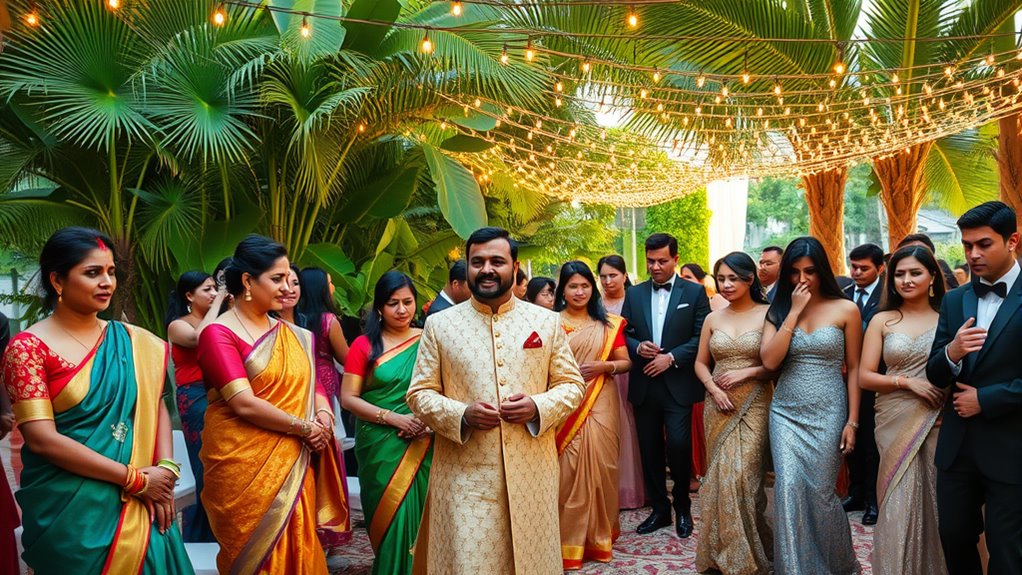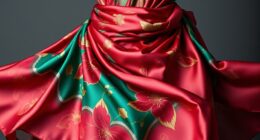When attending a wedding worldwide, dress codes vary widely. Western formal events often require black-tie or cocktail attire, emphasizing elegance and seasonality. In Asia and the Middle East, traditional garments feature vibrant fabrics, embroidery, and meaningful accessories that celebrate culture. African and Latin American celebrations burst with bold colors, intricate patterns, and symbols. To look respectful and stylish, it helps to comprehend these customs—exploring further can ensure you’re perfectly dressed for any wedding.
Key Takeaways
- Western dress codes like black-tie and cocktail attire emphasize tuxedos, suits, or elegant dresses, with seasonal considerations.
- Asian and Middle Eastern traditional attire features vibrant fabrics, embroidery, and accessories that reflect cultural heritage and significance.
- In Africa and Latin America, celebrations often showcase bright colors, bold patterns, and symbolic textiles suitable for lively festivities.
- Proper dress aligns with event formality, showing respect and enhancing the overall wedding experience across different cultures.
- Ignoring dress codes or cultural attire can lead to perceived disrespect and diminish the event’s cultural and social value.
Western Formal Attire: Black-Tie, Cocktail, and More

Western formal attire for weddings includes a range of dress codes like black-tie and cocktail attire, each with specific expectations. You should choose your outfit based on the season and the event’s dress code to avoid common dress code violations. For black-tie, opt for a tuxedo, ensuring it’s well-fitted and appropriate for the season, whether summer or winter. Cocktail attire calls for a sophisticated dress or a tailored suit, but avoid overly casual or flashy options that clash with the event’s formality. Staying within these guidelines shows respect for the couple and the occasion. Remember, dressing correctly isn’t just about style—it’s about fitting into the event’s atmosphere. Ignoring these details can make you stand out in a way that’s unwelcome and diminishes the event’s elegance.
Traditional Attire Across Asia and the Middle East

Across Asia and the Middle East, traditional wedding attire is rich in symbolism and reflects cultural heritage, often featuring vibrant colors, intricate embroidery, and distinctive accessories. You might wear garments made from traditional fabrics like silk, brocade, or velvet, which symbolize prosperity and status. These fabrics are often adorned with detailed embroidery, reflecting regional motifs and craftsmanship passed down through generations. Cultural accessories, such as elaborate jewelry, headpieces, or sashes, complete the look and carry cultural significance. These elements not only enhance the visual appeal but also honor traditions and customs. When attending a wedding in these regions, understanding the importance of traditional fabrics and accessories helps you appreciate the cultural depth behind each outfit, making your presence respectful and meaningful.
Vibrant and Cultural Celebrations in Africa and Latin America

Vibrant and cultural celebrations in Africa and Latin America showcase bold colors, intricate patterns, and meaningful symbols that reflect each region’s unique heritage. When attending these weddings, you’ll notice the use of african textiles and latin american vibrant dresses, which are central to the festivities. To honor the culture, consider:
- Wearing bright, patterned fabrics inspired by traditional african textiles.
- Choosing vibrant dresses with lively colors typical of Latin American styles.
- Incorporating accessories that feature regional symbols or handcrafted details.
- Avoiding subdued or monochrome outfits that clash with the celebration’s lively atmosphere.
These elements help you blend in respectfully with the cultural richness, while also celebrating the joyful spirit of the event. Your attire should mirror the vibrant energy and significance of the occasion.
Tips for Respectful and Stylish Dressing in Global Weddings

When attending a global wedding, dressing respectfully and stylishly requires understanding and honoring the host culture’s customs and traditions. To do so, research local dress codes and adapt seasonal dress trends to fit the occasion. Incorporate eco-friendly fashion choices like sustainable fabrics to show respect for the environment. Balance tradition with modern style by selecting elegant, culturally appropriate attire. Here’s a quick guide:
| Culture | Dress Tip | Eco-Friendly Options |
|---|---|---|
| Asian | Cover shoulders, modest length | Recycled silk or hemp fabrics |
| Middle Eastern | Loose, flowing garments | Organic cotton or linen |
| European | Sophisticated, minimal accessories | Fair-trade materials |
Being aware of affiliate marketing disclosures can help you make informed choices about the products you select for wedding attire, ensuring transparency and trust.
Frequently Asked Questions
How Do Dress Codes Vary for Same-Sex Weddings Worldwide?
You might notice that dress codes for same-sex weddings vary widely due to cultural symbolism and traditional attire. In some cultures, you’re encouraged to wear outfits that honor local customs, like colorful garments or specific accessories. In others, contemporary formal wear is acceptable, regardless of gender norms. Always consider the couple’s preferences and the cultural context to show respect and celebrate their union appropriately.
Are There Specific Colors Considered Inappropriate for Wedding Guest Attire Globally?
When it comes to wedding guest attire, you should steer clear of forbidden hues that might offend, as cultural color taboos vary worldwide. Bright white is often off-limits in many cultures, symbolizing purity and reserved for the bride. In some places, black can be seen as mourning. So, while it’s tempting to wear your favorite shade, it’s best to do your homework and avoid these tricky colors to stay respectful.
What Accessories Are Culturally Appropriate for Diverse Wedding Dress Codes?
When choosing accessories for diverse wedding dress codes, you should consider cultural jewelry and traditional headwear. These elements show respect and appreciation for the couple’s background. For example, wearing a delicate necklace or earrings with cultural significance or a traditional headpiece can enhance your outfit. Always research the specific customs of the wedding’s culture, and when in doubt, opt for understated pieces that honor tradition without overshadowing the celebration.
How Do Age and Gender Influence Dress Expectations at International Weddings?
You should consider how age and gender influence cultural dress expectations at international weddings. Younger guests might wear more modern or vibrant attire, while older attendees often follow age-specific attire guidelines that emphasize elegance and tradition. Gender roles can also shape dress choices, with women typically wearing dresses or sarees and men opting for suits or traditional garments. Being mindful of these factors helps you respect cultural norms and dress appropriately for the occasion.
Are There Any Common Faux Pas to Avoid in Global Wedding Guest Fashion?
Stepping into a global wedding can feel like walking a tightrope over a sea of cultural sensitivities. To avoid faux pas, steer clear of overly revealing outfits and disrespecting local customs. Dress modestly when required, and opt for neutral tones if unsure. Remember, your outfit should harmonize with the celebration’s cultural melody, not drown it out. Respectful attire shows appreciation and helps you blend seamlessly into the wedding’s rich tapestry.
Conclusion
Dressing for a wedding abroad is like steering a colorful tapestry—you get to weave your style into vibrant traditions. By understanding each culture’s dress code, you show respect and appreciation for their unique celebration. Think of it as adding your own brushstroke to a masterpiece, blending respect with style. So, embrace the diversity, stay stylish, and let your wardrobe be a bridge that connects you to the heart of every global wedding.








